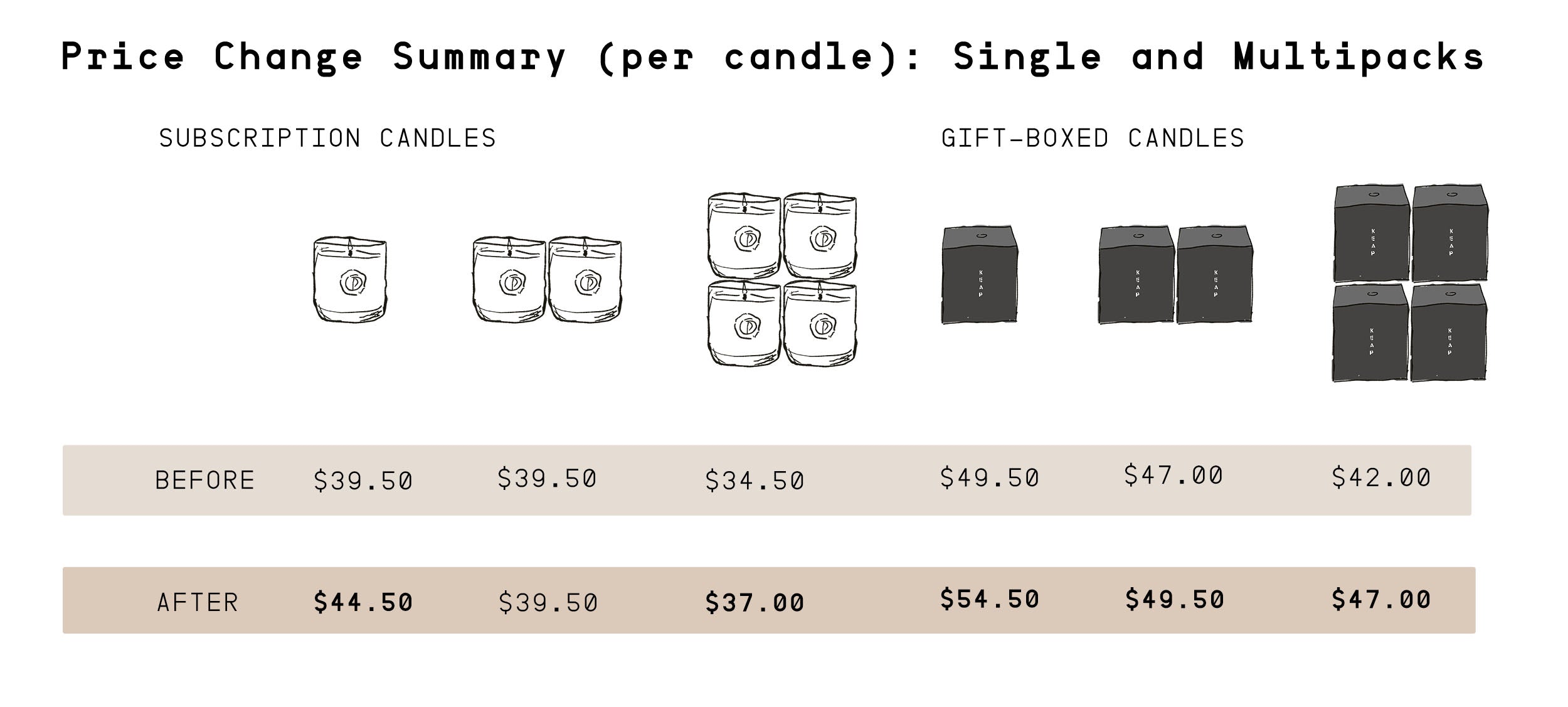With the price change we announced recently, I wanted to write more about the reality of pricing our candles through two separate lenses: the philosophical and the practical.
[Editor's note: This is the practical post. See this other post if you want to learn more about the deeper philosophy that underpins how we think about pricing.]
Price increases have been all over the news the past few months and have likely already been affecting you. On March 1st, 2022, we will be increasing the prices of our candles for the first time in over two years (our last price increase was in late 2019). Given our intimate knowledge of our own price change, we can demystify why we needed to do this and shed some light on the broader economic trends affecting us all.
What Makes a Price?
In simple terms, the price for a product is driven by a simple equation. It is a function of how much it costs to produce the item (the cost of goods) plus a gross margin. The gross margin is the amount charged above and beyond what it costs to produce the item. In general, a price will be significantly above the cost of goods since a producer has to have enough gross margin to pay for all the non-manufacturing parts of running the business, e.g., rent, long-term investments, non-manufacturing salaries, etc.
Each business has to determine its own gross margin based on its specific industry, business model, values, and vision. We wrote more about our pricing philosophy here, but in short, our prices reflect the deeper purpose behind our work and the costs associated with living up to that purpose, both now and into the future. We have learned over these past years that we need to price our core candle subscription at a 50% gross margin to allow us to run our business successfully.
Healthy pricing helps cover all the cost of making candles, rent, administrative, and other expenses for Keap, as well as parts of our candle-making and shipping salaries not directly related to candle production, e.g. cleaning, quality improvements, research and development, etc. Our remaining profits (currently <1%) are reinvested back into the company currently, with a long-term ownership transition plan to begin profit sharing.

Keap’s Cost Breakdown (2021 Data)
The Up and Up
As the cost of goods or other costs associated with running a business increase (as they tend to do), a company has few choices. It can try to reduce the cost of goods in some way, or it can operate on lower margins. While these are feasible courses of action, they will necessarily mean less money invested in the business’s product, team, and operations. Though price increases may seem unpalatable in the present, the alternatives are worse in the long run. A price increase, on the other hand, can ensure a healthy margin is maintained, allowing a business to operate in line with its needs and purpose.

The Squeeze
We last increased our price in 2019 in order to set Keap up with a healthy margin of 50% to cover our costs and allow us to continue to invest in our long-term vision. Since 2019, we’ve seen the costs associated with producing our candles increase by roughly $3 per candle — a 15% increase in cost of goods. For example, our coconut wax has increased from $1.59 to $2.29 per pound (a 44% increase in costs), and our fragrance suppliers have increased prices across all ingredients, translating to $0.30-0.60 more costs per candle (8%-17% increases).
All this means that, at our current price, we are at an average 43% gross margin on our subscription vs. our stated goal of 50%. This may sound like a small difference, but we learned in our early years that each of those missing percentage points add to our feeling of being squeezed. As noted above, decreasing margins force cost-cutting and underinvesting in our product, team, facilities, and, ultimately, our future.
The cost increases we face echo larger trends affecting many areas of the economy. The pandemic increased savings, leading to latent demand for various items, while also decreasing the capacity of companies to hire and produce. The knock-on impact of limited supply and pent-up demand has been price inflation: increasing prices of cost of goods, which are now being passed on to shoppers in the form of higher consumer prices.
 Our total average costs for delivery of a subscription candle are $22.09, a 43% gross margin at our 2021 pricing of $39.50 per candle. (Jan. 2022)
Our total average costs for delivery of a subscription candle are $22.09, a 43% gross margin at our 2021 pricing of $39.50 per candle. (Jan. 2022)
Method in the Margins
Based on the Cost of Goods increases we’ve experienced, we will be increasing our prices to allow us to maintain the Gross Margin necessary for continuing to run Keap according to our vision and values. Our base subscription price will increase from $39.50 to $44.50 for one candle, monthly, which brings us back to a 50% gross margin.
While the price increase is necessary for Keap to be financially sustainable, we know how hard increasing prices have been for all of us. We have devised a few new ways that folks continue to enjoy our candles at or even below our current prices.
- Firstly we will be expanding the discounts we offer when you buy candle multipacks. When you purchase more than one of our candles at a time, there are major shipping savings. By passing these savings back to you, we can offer a better price per candle on multipacks — you will save $10 per extra candle. This will keep our prices the same or similar to before when ordering more than one candle. Below is a summary of the cost per candle before and after the price change at different quantities — one, two, and four candles.

- Secondly, in a few months, we’re also going to be launching another subscriber benefit: access to our Studio Seconds sales, a.k.a. those candles that are perfectly fine but did not pass our visual quality checks. We’ll be selling Seconds candles by the dozen at only $15 per candle. So if you’re looking for our best possible value, this will be it!
In some ways pricing is formulaic: know your costs and set an appropriate margin above this to run a business. Yet, everyday price and margin decisions also capture reflections of deeper ideas we share as individuals and as a culture: expressions of hopes, aspirations and dreams, personal preferences and needs. We believe the iconic companies of the next hundred years will be revered for the way they nourished the people and environments they touched, and we’re proud that our prices reflect this stance.
Thanks for taking the time to engage with us on this topic.
Cheers,













